
The 8.8 cm KwK 36 was an 88-millimetre (3.5 in) tank gun used by the German Army during World War II. This was the primary armament of the PzKpfw VI Tiger I tank. It was developed and built by Krupp.

The Goalkeeper CIWS is a Dutch close-in weapon system (SEE-wiz) introduced in 1979. It is an autonomous and completely automatic weapon system for short-range defence of ships against highly manoeuvrable missiles, aircraft and fast-manoeuvering surface vessels. Once activated the system automatically undertakes the entire air defence process from surveillance and detection to destruction, including the selection of the next priority target.
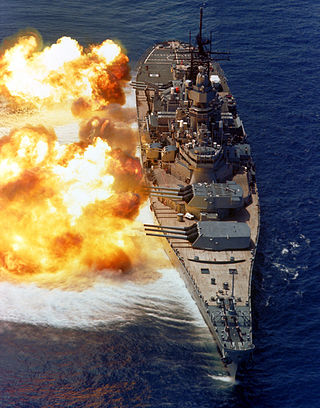
The 16"/50 caliber Mark 7 – United States Naval Gun is the main armament of the Iowa-class battleships and was the planned main armament of the cancelled Montana-class battleship.

The Convair RIM-2 Terrier was a two-stage medium-range naval surface-to-air missile (SAM), and was among the earliest surface-to-air missiles to equip United States Navy ships. It underwent significant upgrades while in service, starting with beam-riding guidance with a 10-nautical-mile (19 km) range at a speed of Mach 1.8, and ending as a semi-active radar homing system with a range of 40 nmi (74 km) at speeds as high as Mach 3. It was replaced in service by the RIM-67 Standard ER (SM-1ER).

Seaslug was a first-generation surface-to-air missile designed by Armstrong Whitworth for use by the Royal Navy. Tracing its history as far back as 1943's LOPGAP design, it came into operational service in 1961 and was still in use at the time of the Falklands War in 1982.

The Type 052 (NATO/OSD Luhu-class destroyer is a class of destroyers developed in the People's Republic of China for the People's Liberation Army Navy. The Type 052 was an intermediate between the obsolescent Type 051 and the modern Type 052B destroyers. They were the first PLAN destroyers powered by gas turbines, and the first PLAN ships with modern combat direction systems. They were also part of the first generation of PLAN warships armed with surface-to-air missiles in the form of the short-range Crotale

The Type 81 Surface-to-Air Missile (81式短距離地対空誘導弾) or Tan-SAM (短SAM) is a Japanese developed surface-to-air missile currently in service with the Japan Ground Self-Defense Force.

The Brahmaputra-class frigates are guided-missile frigates of the Indian Navy, designed and built in India. They are an enhancement of the Godavari class, with a displacement of 3850 tons and a length of 126 metres (413 ft). Although of similar hull and dimension, internally, the Brahmaputra and Godavari classes have different configurations, armaments and capabilities. 3 ships of this class serve in the Indian Navy.
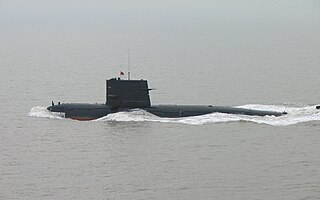
The Type 039 submarine is a class of diesel-electric submarines of the People's Liberation Army Navy. The class is the first diesel-electric submarine to be fully developed within China and also the first Chinese diesel-electric submarine to use the teardrop hull shape.

The Type 345 (MR35) fire-control radar system is used to guide the HQ-7 short-range surface-to-air missile. The system is installed on many modern, and retrofitted Chinese navy ships.

The Type 360 is an air/surface search radar manufactured by Yangzhou Marine Electronic Instruments Research Institute (扬州船用电子仪器研究所)/ No. 723 Institute and is reportedly based on Selenia RAN-10S / SPS – 774. It is deployed on a number of new PLAN vessels, such as the Ma'anshan class frigate.
The People's Liberation Army Navy (PLAN) is the naval branch of the People's Liberation Army (PLA), the armed forces of the People's Republic of China. The PLAN force consists of approximately 250,000 men and over a hundred major combat vessels, organized into three fleets: the North Sea Fleet, the East Sea Fleet, and the South Sea Fleet.
The Type 347G "Rice Bowl" I-band fire-control radar is found on Chinese Navy ships, in conjunction with the Type 76A dual-37mm automatic AAA gun. Typically, the system includes 2 Type 347G fire-control radar with optical director, and 4 Type 76A guns. They're used on the Luda, Luhu, Luhai, Jiangwei class surface warships, as well as the Houjian, Houxin, and Haiging class patrol boats.
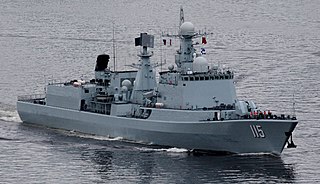
The Type 051C destroyer is a long-range air-defence guided-missile destroyer built by China in its ongoing effort to create a true blue water navy. The ship uses the hull design of the older Type 051B, but is equipped with the advanced Russian S-300FM air defence missiles systems. Currently, two ships of this class have been launched and deployed by People's Liberation Army Navy North Sea Fleet.

The AN/SPS-48 is a US naval electronically scanned array air search three-dimensional radar system manufactured by ITT Exelis and deployed in the 1960s as the primary air search sensor for anti-aircraft warships. The deployment of the AN/SPY-1 and the end of the Cold War led to the decommissioning of many such ships, and many of these vessels AN/SPS-48 sets were reused on aircraft carriers and amphibious ships, where it is used to direct targets for air defense systems such as the Sea Sparrow and RIM-116 SAM missiles. Existing sets are being modernized under the ROAR program to AN/SPS-48G standard for better reliability and usability.
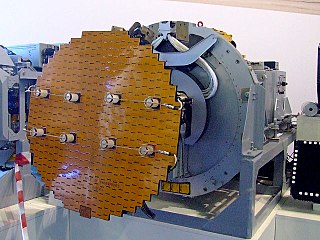
The Zhuk are a family of Russian all-weather multimode airborne radars developed by NIIR Phazotron for multi-role combat aircraft such as the MiG-29 and the Su-27. The PESA versions were also known as the Sokol.
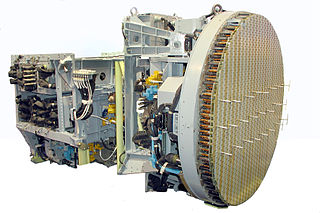
The Bars (Leopard) is a family of Russian all-weather multimode airborne radars developed by the Tikhomirov Scientific Research Institute of Instrument Design for multi-role combat aircraft such as the Su-27 and the MiG-29.
Radar in World War II greatly influenced many important aspects of the conflict. This revolutionary new technology of radio-based detection and tracking was used by both the Allies and Axis powers in World War II, which had evolved independently in a number of nations during the mid 1930s. At the outbreak of war in September 1939, both Great Britain and Germany had functioning radar systems. In Great Britain, it was called RDF, Range and Direction Finding, while in Germany the name Funkmeß (radio-measuring) was used, with apparatuses called Funkmessgerät . By the time of the Battle of Britain in mid-1940, the Royal Air Force (RAF) had fully integrated RDF as part of the national air defence.

The AN/SPY-1 is a United States Navy 3D radar system manufactured by Lockheed Martin. The array is a passive electronically scanned system and a key component of the Aegis Combat System. The system is computer controlled and uses four complementary antennas to provide 360-degree coverage. The system was first installed in 1973 on USS Norton Sound and entered active service in 1983 as the SPY-1A on USS Ticonderoga. The -1A was installed on ships up to CG-58, with the -1B upgrade first installed on USS Princeton in 1986. The upgraded -1B(V) was retrofitted to existing ships from CG-59 up to the last, USS Port Royal.

The AK-130 is a Russian designed automatic dual barrel naval cannon with a caliber of 130 millimetres (5.1 in), capable of firing 10-40 rounds per minute.
















